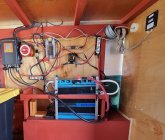To amplify, the time thing is related to surge rating. As in 200% of rated capacity for X minutes. 120% for XX minutes. Continuous means continuous.
There is a qualifier about continuous related to ambient temperature. The limiting factor for continuous power rating is heat dissipation. Heat sinks and fans don't work as well when the air around a device is hotter.
I recently designed a wireless base station that has to operate inside a control electronics enclosure that is used in the middle east, in direct sun. Operating temperature spec is -40 to 80 degrees C. 80 degrees C is 176 degrees F! That was not easy.
Hardest thing to find was a galvanically isolated DC-DC converter module with high temperature specs. Most top out at 70 degree C. I found one made by Traco with a 93 degree C spec. The reason why this matters is when a manufacturer specs the temperature range, the top temp is where the derated current you can draw = 0.
So having an 80 degrees C rating doesn't really help when it means I can't actually draw any power out of the darn thing at 80. This was literally the only part I could use.
Order TRACO Power TEC 2-2413WI DC/DC converter on-line or call today for exceptional customer service and factory trained expert TRACO Power TEC 2-2413WI knowledge. TRC is the USA stocking headquarters of TRACO Power TEC 2-2413WI DC/DC converters.

www.trcelectronics.com




